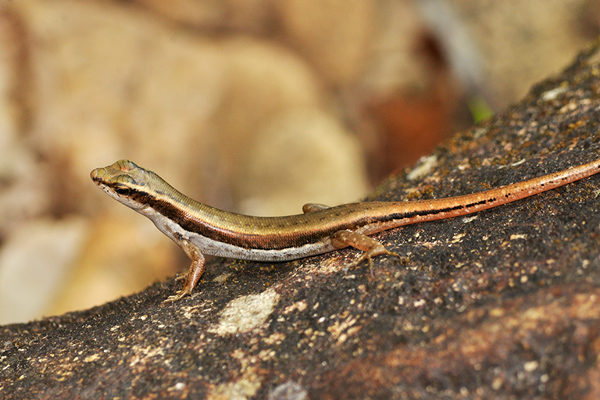todozoo.com – Skinks are a diverse family of lizards (Scincidae) known for their smooth, shiny scales and often secretive habits. With over 1,500 species distributed across the globe, they inhabit a wide range of habitats, from deserts and grasslands to forests and even semi-aquatic environments. Their adaptability and unique characteristics make them a fascinating group of reptiles.
Physical Characteristics: Smooth Scales and Varied Body Plans
Skinks are easily recognizable by their smooth, overlapping scales, which give them a polished, almost metallic appearance. This smooth skin reduces friction, allowing them to burrow easily through soil and leaf litter. Other common physical characteristics include:
- Cylindrical Bodies: Most skinks have elongated, cylindrical bodies, well-suited for navigating tight spaces.
- Short Limbs (Often Reduced): While most skinks have four limbs, these are often short and sometimes reduced in size, especially in burrowing species. Some species have even lost their limbs entirely, resembling snakes.
- Conical Snouts: Many skinks have pointed or conical snouts, which aid in digging and foraging.
- Tail Autotomy: Like many other lizards, skinks possess the ability to shed their tails (autotomy) as a defense mechanism against predators. The detached tail continues to wiggle, distracting the predator while the skink escapes. The tail will eventually regenerate, although the new tail may be shorter and differently colored.
Size and Coloration: From Tiny to Robust
Skinks exhibit a range of sizes, from small species measuring only a few centimeters in length to larger species reaching up to 30 centimeters or more. Their coloration is equally diverse, ranging from drab browns and grays to vibrant blues, greens, reds, and even metallic sheens. Some species have striking patterns, such as stripes, spots, or blotches.
Habitats and Distribution: A Global Presence
Skinks are found on every continent except Antarctica, occupying a wide variety of habitats:
- Deserts and Arid Regions: Many skink species are well-adapted to arid environments, with adaptations for conserving water and tolerating high temperatures.
- Grasslands and Savannas: These open habitats provide ample opportunities for skinks to forage for insects and other prey.
- Forests and Woodlands: Skinks in forested areas often live in leaf litter, under logs, or in burrows.
- Coastal Areas and Islands: Some skink species are found in coastal habitats, including sandy beaches and rocky shores.
- Semi-aquatic Environments: A few skink species are semi-aquatic, inhabiting marshes, swamps, and stream banks.
Diet and Foraging: Primarily Insectivores
Most skinks are primarily insectivores, feeding on a variety of insects, spiders, and other invertebrates. Larger species may also consume small vertebrates, such as lizards, frogs, and baby mice. Skinks are typically active foragers, using their keen eyesight and sense of smell to locate prey.
Reproduction: Diverse Strategies
Skinks exhibit various reproductive strategies:
- Oviparity (Egg-laying): Most skink species are oviparous, laying eggs in nests constructed in burrows, under rocks, or in leaf litter.
- Viviparity (Live birth): Some skink species are viviparous, giving birth to live young. This adaptation is more common in cooler climates.
Behavior: Secretive and Agile
Skinks are often secretive and difficult to observe, spending much of their time hidden under rocks, logs, or in burrows. They are generally active during the day (diurnal), although some species may be crepuscular (active at dawn and dusk). They are quick and agile, using their smooth scales and streamlined bodies to escape predators.
Defense Mechanisms: Avoiding Predation
Skinks have several defense mechanisms to avoid predation:
- Camouflage: Many skinks blend in well with their surroundings, making them difficult to spot.
- Burrowing: Their ability to burrow quickly provides a safe refuge from predators.
- Tail Autotomy: As mentioned earlier, shedding the tail is a common defense strategy.
- Speed and Agility: Their quick movements and agility allow them to evade predators.
Ecological Importance: A Role in the Food Web
Skinks play an important role in ecosystems as both predators and prey. They help control insect populations and serve as a food source for larger animals, such as birds, snakes, and mammals.
Conservation Status: Threats and Challenges
While many skink species are common and widespread, some face threats such as habitat loss, degradation, and fragmentation, as well as introduced predators and climate change. Conservation efforts are important to protect these fascinating reptiles and their diverse habitats.
Conclusion: A World of Smooth Scales and Secret Lives
Skinks are a diverse and fascinating group of lizards, exhibiting a wide range of adaptations and behaviors. Their smooth scales, secretive habits, and ecological roles make them an important part of ecosystems around the world. Understanding and appreciating their diversity is crucial for their conservation and the health of our planet.
